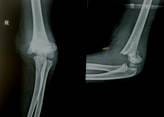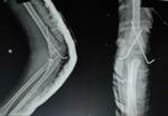Open versus closed reduction and K-wire fixation for supracondylar fracture of the humerus (Gartland type 3) in children
Kumar Kirar S.1, Upadhyay S.2*, Singh S.3, Varshney A.4
DOI: https://doi.org/10.17511/ijoso.2021.i03.02
1 Sunil Kumar Kirar, Senior Resident, Department of Orthopaedics, ABV Government Medical College, Vidisha, Madhya Pradesh, India.
2* Sanjay Upadhyay, Assistant Professor, Department of Orthopaedics, ABV Government Medical College, Vidisha, Madhya Prdaesh, India.
3 Sanat Singh, Associate Professor, Department of Orthopaedics, ABV Government Medical College, Vidisha, Madhya Pradesh, India.
4 Atul Varshney, Professor & HOD, Department of Orthopaedics, ABV Government Medical College, Vidisha, Madhya Pradesh, India.
Background: The purpose of the study was to compare the presentation and postoperative results of children treated by open reduction and closed reduction for completely displaced Gartland type III supracondylar humerus fractures (SCFs). Method: Supracondylar fracture of the humerus is a common paediatric fracture seen in our OPD. Among them Type III fractures are displaced with no cortical contact, and reduction is difficult, and maintaining reduction is almost impossible without some form of internal fixation. Therefore during surgery of type 3 fractures, fixation is done by two methods. 1 open reduction and fixation with 2 cross k-wire 2. closed reduction and fixation with 2 cross k-wire fixation. Following pinning, the elbow was immobilized in an above elbow slab in pronation with the elbow at 75 degrees of flexion. Result: The average age of patients was 5 years (age range, 3 to 10 years). The test population consisted of 18female (36%) and 32 male (64%) patients. There were 31 fractures (62%) in the right elbow and 19 fractures (38%) in the left. Group 1 patients stayed in the hospital for 5 days while Group 2 stayed for only 2 days in the hospital. Also group 1 patient required follow-up at eight postoperative days (for check dressing) and 11 postoperative days for stitch removal while group 2 patients were directly called for k-wire removal at 3 weeks postoperatively. Both groups of patients were called after three weeks for k-wire removal. Mean clinical follow-up for both groups was 6 months. Conclusion: The closed reduction technique was preferred because it required less hospitalization time, less number followup, and resulted in almost no visible surgical scars.
Keywords: Closed reduction, Displaced fracture, Supracondylar fracture, Trauma
| Corresponding Author | How to Cite this Article | To Browse |
|---|---|---|
| , Assistant Professor, Department of Orthopaedics, ABV Government Medical College, Vidisha, Madhya Prdaesh, India. Email: |
Kirar SK, Upadhyay S, Singh S, Varshney A. Open versus closed reduction and K-wire fixation for supracondylar fracture of the humerus (Gartland type 3) in children. Surgical Rev Int J Surg Trauma Orthoped. 2021;7(3):44-50. Available From https://surgical.medresearch.in/index.php/ijoso/article/view/225 |


 ©
© 
